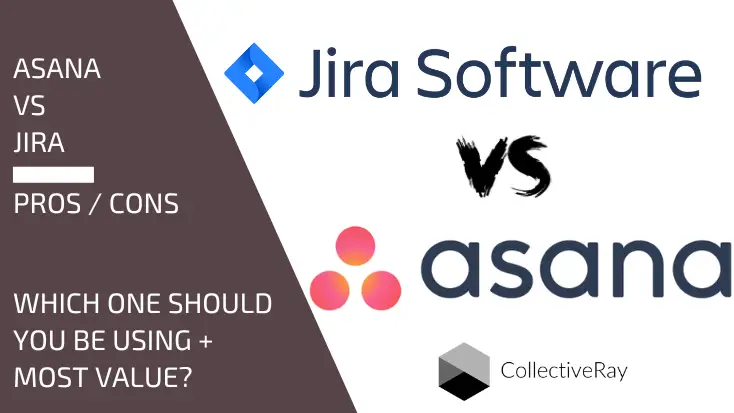
Although Asana and Jira are both popular project management tools, their approaches are very different. We'll see how this works out in practice in this Asana vs Jira comparison before declaring a winner.
You'll come across the names Asana and Jira when looking for the best free project management software.
Both are fantastic tools in their own right, and we've talked about them extensively. However, because we're obsessed with rankings here at Cloudwards, we're pitting Asana against Jira in this article to see who comes out on top.
{autotoc}
Summary
- If you're a small group of software developers, go with Jira and don't look back unless your company grows significantly. Jira is free for teams with fewer than ten members, and its features cater to Agile teams.
- Jira loses a lot of its appeal if you're not into Agile, and Asana is a better option. It's a much more comprehensive project management tool, and you can use it to run any type of business of any size.
- If you just look at the price in dollars, Jira is a lot cheaper than Asana, but Asana makes up for it with a slew of useful features. As a result, if money is a major concern for you, you'll need to think twice.
To cut a long story short, Asana is the winner. As you can see from our full Asana review, it has a tonne of features, is extremely easy to use, and has a fantastic knowledge base.
As we explain in our Jira review, Jira is an excellent project management tool, but it pales in comparison to Asana. However, it isn't entirely a one-sided thrashing, and Jira fights back valiantly.
Before we get into that, we'd like to give a quick shout-out to monday.com, the winner of our best project management software roundup.
While Jira and Asana are both close to taking the crown, monday.com remains the undisputed king, and we recommend that anyone looking for a great all-around tool read our monday.com review.
“Simply using Jira doesn’t mean you’re agile.”
– Claire Drumond, Atlassian Head of Product Marketing, Jira Software and Agile
Asana vs Jira: A Project Management Tool Showdown
If you're joining us for one of our mini-fights for the first time, let us quickly go over the rules. Over the course of five rounds, we'll compare our two contenders based on the criteria in our project management reviews.
Each round has a winner — or a tie — and at the end, the points are totaled and a winner is declared.
Features
Asana wins our first round with ease. It's one of the most feature-rich project management tools available, even outperforming Monday.com in a few key areas, which is why Asana fans should consider it as a viable alternative (check out our Asana vs monday.com article for that titanic battle).
Jira has no chance because the better competitor is simply using it for target practise.
That's not to say Jira isn't useful; it's just that Atlassian, Jira's parent company, chose a more streamlined approach. There appear to be two reasons for this: the first is that Jira's Agile philosophy is a very streamlined method for getting work done that avoids doodads.
The second reason is that Atlassian prefers to provide simple software that users can customise to their specific requirements. We see something similar with Jira's sibling Trello, where third-party integrations can end up making up more of the programme than its core in some cases.
For more information, see our Jira vs. Trello comparison, as well as our guide to integrating Jira and Trello.
Jira Features
We'll get into integrations a little more later in this round, but for now, let's focus on Jira's core features. It's essentially a scrum board or kanban board (each project can only have one of these), plus a few supporting actors such as a code repository, right out of the box.
This is not a value judgment: if something works, it works. Users create task cards (or "issues," as Jira refers to them), which are then placed on the kanban board and ready to be dragged and dropped. It's a great way to keep a consistent schedule.
Instead of a linear set of tasks, a software development team will likely spend more time on the scrum board, where "sprints" — tasks that must be completed in a short period of time — are set up.
It works really well to start a sprint by first creating issues in the backlog and then importing them onto the scrum board.
Agile teams will typically work on a project from sprint to sprint until it is completed.
The scrum itself won't provide much of an overview, but Jira has added a "roadmap" that will allow you to track a project's overall progress. We like the roadmap, but we wish there were more ways to get some oversight while using Jira; as we discussed in our Wrike vs Asana comparison, it's not impossible.
Asana Capabilities

Asana is a general task management tool that can be used for any type of project, whereas Jira is geared toward software development. It has a lot of standard functionality that you'd find on monday.com, for example, but you can also create custom functions — within reason — to meet any unique requirements you might have.
But first, let's talk about how it's used in the real world. You can work in a variety of environments, known as "views," such as a list, kanban, calendar, and (if you upgrade) timeline, among others.
That may sound intimidating, but it's actually quite simple: you create tasks in one of the views, such as the list view (which we recommend), and the views are simply ways to organise them.
You might, for example, add a set of tasks to your to-do list and assign them due dates, priority stickers, and a status.
After that, you can switch to a kanban view to see the status of all your cards, a chart to see how many tasks are assigned to which priority, and finally a calendar view to see when everything is due.
When used correctly, Asana gives you a lot of control and oversight, and it blows Jira out of the water in this regard.
This is also the most significant distinction between Jira and Asana: Jira only allows for two views per project.
The roadmap is the only good way to get any oversight when putting together a large project, which is good but not great. You can use Asana to see not only what's going on right now, but also what's going to happen in the future.
Read More: Airtable vs Asana
Team Member Management in Asana vs Jira
Next on our Asana vs Jira showndown, we'll look at how teams are handled on both tools.

In Asana, team members are also managed much more effectively. Of course, Jira allows you to add anyone to your board (just enter their name and email address — you can also upload a photo), but filtering by team members only shows you the tasks that have been assigned to them.
In comparison, Asana can show you what they're working on and when they're working on it, as well as compare the workloads of individual team members using the eponymous (or, name) view.
Of course, these are just a few of the highlights; there are many more. Harvest, for example, is an integrated time-tracking app, and the portfolio view gives you a bird's-eye view of multiple projects at once.
This last one is ideal for project managers who manage their own managers (pretty sure we won a bet with that sentence).
When comparing the features of Asana and Jira, there are two things to keep in mind. The first is that Jira's free plan unlocks most features, whereas Asana's features are jealously guarded behind several tiers of payment.
In the next section, we'll go over this in greater detail. The second point is that Jira can accomplish a lot through integrations, which we'll discuss now.
Asana vs Jira Integrations
All of the project management software we looked at can integrate with third-party add-ons in some way.
There's no way that a single solution can meet all of your requirements. Task management tools are used in a variety of industries and companies, so having one that rules them all is nearly impossible.
You have a few options for dealing with this problem. You can follow Atlassian's lead, which creates products that are both lightweight and open to add-ons. Jira is one such example, though its sibling Trello is even more adaptable (read our Trello review for more).
You could, on the other hand, follow Asana's lead and make your software flexible enough to handle most scenarios while restricting integrations to specific apps.
Both methods are effective, and you can even combine them so that Jira "issues" appear in Asana as "tasks."
Because there isn't a native application for Asana, this is a good compromise if you're an Agile team that uses it. Even though Asana has a guide for creating a scrum board, it isn't likely to win our best scrum software award any time soon.
Of course, Jira has much more to offer than Asana. In fact, the number of apps that can be installed is almost limitless. The Atlassian marketplace is where you'll shop for apps, and the selection is endless.
Apps and Add-Ons
The best way to learn what's possible is to test it out for yourself. You could, for example, add a Gantt chart to Jira using a TeamGantt app (read our TeamGantt review) or use an Atlassian integration to create a timeline.
The sky's the limit; the only caveat is that some integrations require you to sign up for the service that provides it, which may require payment.
In this regard, Asana is less adaptable, but it is still a force to be reckoned with. We particularly like how the paid plans allow you to integrate Salesforce and Adobe products, resulting in a more seamless assignment distribution experience.
Aside from that, you can also integrate cloud storage services and collaboration tools like Slack.
Of course, if you can't find the add-on you're looking for Asana or Jira, or if it doesn't work as well as you'd like, you can always use Zapier or IFTTT to create your own custom scripts. Whatever option you choose, you're not going to run out of ways to use Asana or Jira anytime soon.
Pricing
We'll move on to a less conclusive round now that Asana has a solid win under its belt.
The thing is, Jira has much better pricing in terms of dollars and cents, but we believe Asana offers much better value in terms of bang for your buck. To explain, we'll have to get a little more technical. Let's begin with Jira's costs.
Jira Pricing
Jira is, as you can see, a bargain. Only Freedcamp comes close, and it's not even close to being as good.
That is, assuming you choose to pay for Jira. Small development teams with fewer than 10 users could theoretically use Jira for free indefinitely, as the free plan includes all truly essential features. This is something that Asana could benefit from, but we'll get to that later. For now, we'll just talk about paid plans.
Jira costs $7.75 per user per month if you upgrade to the Standard plan, and $8.5 more if you upgrade to the Premium plan, totaling $15.25. (assuming you pay per year, which you should in most cases).
By any standard, that's a bargain, but when compared to others, such as our monday.com vs Jira comparison, the difference can be startling. Let's compare Asana's prices to those of other yoga studios.
Asana Pricing
That's a jarring contrast, and that's without even considering the free plan. The Premium plan from Asana costs $10.99 per user per month (assuming an annual subscription), which is $4 more than Jira's Standard plan.
Furthermore, Asana's Business plan costs $24.99 per user per month, $10 more than Jira's Premium plan (confusing nomenclature, we know).
We're excluding Enterprise plans because they provide highly specific and specialised features, mostly related to security and user permissions, that many of our readers don't require.
Surprisingly, based on what we could find on their websites, Jira and Asana both appear to offer essentially the same package at this level.
Value for Money
So, when it comes down to just adding and subtracting dollar amounts, Jira comes out on top. However, if we go back to the previous round, you'll recall that Asana has far more features than Jira.
This is where it becomes difficult to pick a winner: yes, a full upgrade to Jira is significantly less expensive than Asana, but Asana offers so much more.
With all of Asana's features, the Premium plan's price becomes a lot more bearable.
We could still debate whether the Business plan is worthwhile, as many of the features that justify its cost are tailored to specific types of businesses.
For many businesses, however, the four extra dollars for the Premium tier is well worth it, especially since Jira can always be integrated for free.
Even so, it's not an easy decision, especially for smaller businesses. Jira's peculiar approach to pricing for medium and large teams, which we discuss in-depth in our article on Jira pricing, will make it more difficult.
As a result, we're calling this round a tie, though not before mentioning the free plans.
Jira vs Asana: Comparing the Free Version
Both contenders are featured prominently in our guide to free project management software, as we mentioned in the introduction.
This is because, in both cases, if you're willing to make a few concessions and keep your team small, you can complete all of your planning in the free plan without ever spending a dime.
Jira, in particular, is incredible. If you have fewer than ten users, you can get a nearly complete set of management tools for free. We believe that many small teams would be able to get by just fine with it.
The free tier on Asana isn't as good. It's a lot more feature-rich than Jira, but you'll probably want to upgrade much sooner than you would with Jira. Behind the first Premium paywall, there are a few very useful features.
As a result, Jira will be the winner of the free plan sub-competition, but only for software developers. As we enter our round on ease of use, the draw remains the same.
User-Friendliness and UX
So far, Asana has been in the lead, but that changes this round when Jira scores a point to tie the game. Let's see whether the latter can catch up in this Asana vs Jira comparison.
While Asana is simple to use, Jira is simply more so. That's thanks in large part to Jira's quickstart bar, which is one of the best features. In fact, we wish it was available in more project management software.
In a nutshell, the quickstart is a bar on the right-hand side of your screen that guides you through the most basic tasks by allowing you to choose between pop-ups on your screen, watching a video, reading the documentation, or doing all three.
We like it a lot, and the quick bar has made even the more complicated aspects of Jira's operation a lot easier.
Asana, on the other hand, only uses pop-ups, though you can study at your leisure through Asana's vast knowledge base (more on that in the next section). In general, the pop-ups do their job, though the advice can be a little arbitrary at times.
Getting Started
In either case, once you've decided what you want to do, the rest is easy. By entering your email address, you can sign up.
The program then guides you through a series of questions to get you started, and you're ready to go.
You can also invite team members via email, and the majority of navigation is done by dragging and dropping tasks or contextual menus on the side of the screen.
If we're being honest, there's not much that separates the two programs. Both use a card-based system in which you assign tasks and then play around with the details by clicking on them to reveal the details. We like it, and it gets the job done quickly.
If you want to get started with Asana a little faster, we have a full guide, but you could also just muddle through.
This round isn't particularly exciting because both Asana and Jira are extremely user-friendly.
Customer Support
The race is neck and neck after three rounds, but Asana will pull ahead now because it has more support than Jira. It's not a huge difference, but Asana's documentation is better overall, and it allows you to contact the support team at any level. Jira, on the other hand, only offers premium support to paid users. It's worth noting that neither company provides phone support.
We already discussed getting to know both the Asana and Jira software in the previous round, and Jira currently does a better job of it. Asana's documentation, on the other hand, is superior. There's less jargon, and you don't feel obligated to complete an entire Agile terminology course just to read a couple of articles. In addition, the courses available are more well-structured.
In short, Asana makes it easier to learn more about how a program works and why it does what it does. Both offer ticket-based customer service if you run into serious issues. Asana makes it available to everyone, including freemium users, whereas Jira only makes it available to paying customers, making this a clear win for our favorite yoga pose.
Security & Privacy
This final round of our Asana vs Jira review will be a sprint, as it is only a hair away from Asana. The problem is that both contenders provide adequate security, but neither provides adequate privacy. Asana, on the other hand, has a slight edge in terms of privacy, so it wins.
Let us discuss file storage and security. When data is stored in Asana or Jira, it is encrypted with AES-256 encryption while in transit and at rest on the server. Except for one thing, this is fine and meets the same basic requirements as any of our most secure cloud storage services.
Because Asana is only a hair away, the final round will be a sprint. The issue is that while both candidates offer adequate security, neither offers adequate privacy. Asana, on the other hand, has a slight privacy advantage, so it takes the win.
Let's talk about file storage and protection. While in transit and at rest on the server, data in Asana or Jira is encrypted with AES-256 encryption. With one exception, this is fine and meets the same basic requirements as any of our most secure cloud storage services.
The Verdict: Asana vs Jira
There you have it, in our Asana vs Jira showdown - Asana has won. It was a close fight, but Jira's lack of features proved to be his undoing in the end. Nonetheless, it held its own against one of the most popular project management tools, which is more than many others can say.
Winner: Asana
What are your thoughts on our fight? Do you agree with the outcome, or did we overlook something obvious? Please let us know in the comments section below, and thank you for reading.
Asana vs Jira FAQs
For software development, should I use Jira or Asana?
If you're a small group of software developers, go with Jira and don't look back unless your company grows significantly. Jira is free for teams with fewer than ten members, and its features cater to Agile teams. Jira loses a lot of its appeal if you're not into Agile, and Asana is a better option.
What exactly is Asana and how does it function?
Asana is a full-featured web-based platform for tracking and managing projects and tasks across multiple divisions. Software development (complete with bug tracking), business development teams, and marketing teams can all use Asana.
What are the different types of Asana views?
Depending on your team's needs, Asana provides multiple views. If you need a Kanban-style card-and-board interface, all users have access to it the moment they log in. The list view is ideal for those who prefer to have a list of tasks and mark them off as they complete them. A calendar view is also available for a quick overview of the project.



